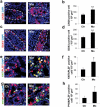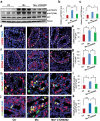Myotubularin related protein 7 is essential for the spermatogonial stem cell homeostasis via PI3K/AKT signaling
- PMID: 31478454
- PMCID: PMC6773228
- DOI: 10.1080/15384101.2019.1661174
Myotubularin related protein 7 is essential for the spermatogonial stem cell homeostasis via PI3K/AKT signaling
Abstract
Myotubularin related protein 7 (MTMR7), a key member of the MTMR family, depicts phosphatase activity and is involved in myogenesis and tumor growth. We have previously identified MTMR7 in the proteomic profile of mouse spermatogonial stem cell (SSC) maturation and differentiation, implying that MTMR7 is associated with neonatal testicular development. In this study, to further explore the distribution and function of MTMR7 in mouse testis, we studied the effect of Mtmr7 knockdown on neonatal testicular development by testicular and SSC culture methods. Our results revealed that MTMR7 is exclusively located in early germ cells. Deficiency of MTMR7 by morpholino in neonatal testis caused excessive SSC proliferation, which was attributable to the aberrant PI3K/AKT signaling activation. Altogether, our study demonstrates that MTMR7 maintains SSC homeostasis by inhibiting PI3K/AKT signaling activation.
Keywords: Myotubularin related protein 7 (MTMR7); PI3K/AKT signaling; germ cells; spermatogonial stem cell (SSC).
Figures








References
-
- McLean DJ, Friel PJ, Johnston DS, et al. Characterization of spermatogonial stem cell maturation and differentiation in neonatal mice. Biol Reprod. 2003;69:2085–2091. - PubMed
MeSH terms
Substances
LinkOut - more resources
Full Text Sources
Other Literature Sources
